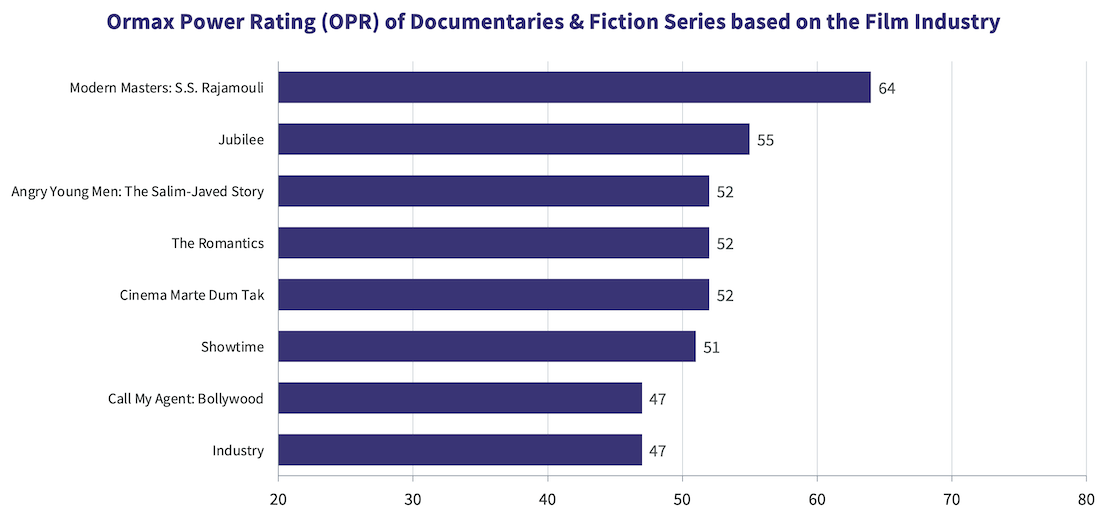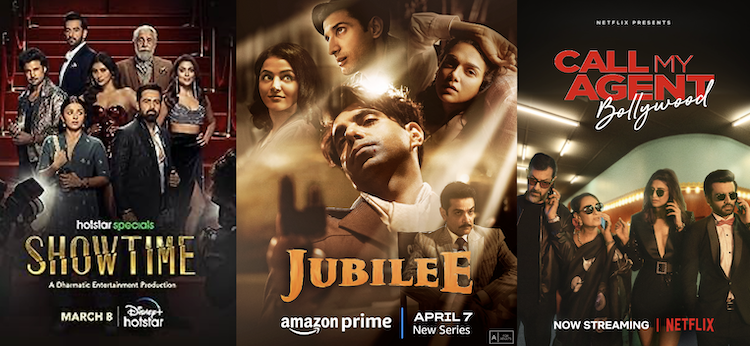


In what appears to be more than mere coincidence, there has been a surge of documentaries based on film personalities and the film industry on streaming platforms over the past year or two. Modern Masters: S.S. Rajamouli (Netflix) and Angry Young Men: The Salim-Javed Story (Prime Video) launched within days of each other, in August 2024. Early last year saw the launch of two well-promoted properties in this sub-genre - Cinema Marte Dum Tak (Prime Video) and The Romantics (Netflix). Over the past 2-3 years, we have also seen fiction series spotlighting the film industry, such as Jubilee, Showtime, Call My Agent Bollywood, and Industry.
While the idea of streaming content - especially documentaries - focused on film personalities or the filmmaking process may seem promising, it’s not necessarily “audience friendly”. The chart below illustrates the Ormax Power Rating (OPR) of the properties mentioned above. OPR is an audience likeability and advocacy metric we use extensively in our Content Testing work. Higher OPR signifies higher advocacy (word-of-mouth) for the show, as well as higher conversion from first weekend to lifetime sampling of the show. Breakout shows typically achieve OPRs in the 70s, while those in the 60s are generally positive, unless high budgets or reputational stakes are involved.
The OPRs in the chart below were collected post the launch of these properties, over a period of four weeks.

Only Modern Masters: S.S. Rajamouli manages to surpass the 60-mark, while all other documentaries and fiction properties fall in the 50s and 40s, indicating mixed to low audience reception.

It is now well understood in our work that stories and themes based on the world of cinema garner limited audience interest. They lack the mainstream appeal needed to engage a broad audience, often catering instead to niche segments like devoted cinema enthusiasts, film students, and industry insiders.
If we look at the theatrical segment, the story is not very different. Several films have been made on stories based in and around the Hindi film industry over the years. In generally, Bollywood-themed films, and those that delve into its inner workings, struggle to engage wider audiences. This is due to limited public interest in an industry often perceived as a peculiar, insular and corrupt world, detached from Indian cultural roots. Additionally, there is limited interest in the craft of filmmaking, lowering the interest in content that delves into these aspects in details.
Over the last two decades, only three major Hindi films with the film industry as the backdrop have performed well at the box office: Sanju, Om Shanti Om, and The Dirty Picture. While all three have protagonists from the film industry, they used the world of cinema as a backdrop, but told stories that high on entertainment and drama. The Dirty Picture promised “Entertainment. Entertainment. Entertainment”, almost as if outlining the formula needed for a film industry-based story to succeed theatrically. Several other films that didn’t manage to do so, struggled at the box office.
Coming back to the context of this article, documentaries focused on the technicalities of filmmaking or the lives of film personalities have little resonance with an average viewer who’s just seeking to be entertained. However, this sub-genre (film-based documentaries) is more likely to resonate in South India, where a stronger film-viewing exists, compared to Hindi-speaking markets. In regions like Tamil Nadu, Andhra Pradesh, Telangana, and Kerala, cinema holds a significant cultural place, and audiences may be more inclined to engage with content that explores the lives of film personalities or the filmmaking process. Additionally, the strong presence of the South Indian diaspora globally strengthens this proposition further. The Rajamouli documentary, which tops the OPR chart above, clearly benefits from these factors, along with the director’s massive equity across India. The coming week brings the release of Nayanthara: Beyond the Fairy Tale on Netflix, offering an opportunity to further test this hypothesis.
Why are we seeing so much content in this sub-genre, then? This seems to be a case of “insider bias”, where individuals (platforms and creators in this case) assume that their own interests or experiences are universally engaging to others. In a crowded market, platforms and creators aim to create content that feels disruptive and unique. While film-based documentaries seem to have this novelty factor, it has worn off by now, with the launch of the documentaries mentioned above in quick succession. In any case interviews, talk shows, or other media formats, especially on YouTube, is replete with similar content.
Only a few years ago, streaming platforms was fascinated by anthologies - a format that received far more emphasis than it deserved (see this 2022 analysis). One hopes film-based documentaries are handled more judiciously, given the limited relevance and interest they have, for the wider Hindi audience at least.

From CTV to Micro Dramas: India's fascinating OTT spectrum
The simultaneous rise of Connected TV and Micro Drama audiences in India over the last year highlights how the Indian OTT market is expanding at both the premium and the mass ends simultaneously

Product update: Content testing for the horror genre
Based on our accumulated audience insights, we are introducing genre-specific drivers for horror films and series in our content testing tools, Ormax Moviescope and Ormax Stream Test

Streaming has a new bias: The male lead
An analysis of 338 Hindi fiction originals since 2022 highlights a growing imbalance in the Indian streaming ecosystem, with male-led stories steadily taking over
Subscribe to stay updated with our latest insights
We use cookies to improve your experience on this site. To find out more, read our Privacy Policy